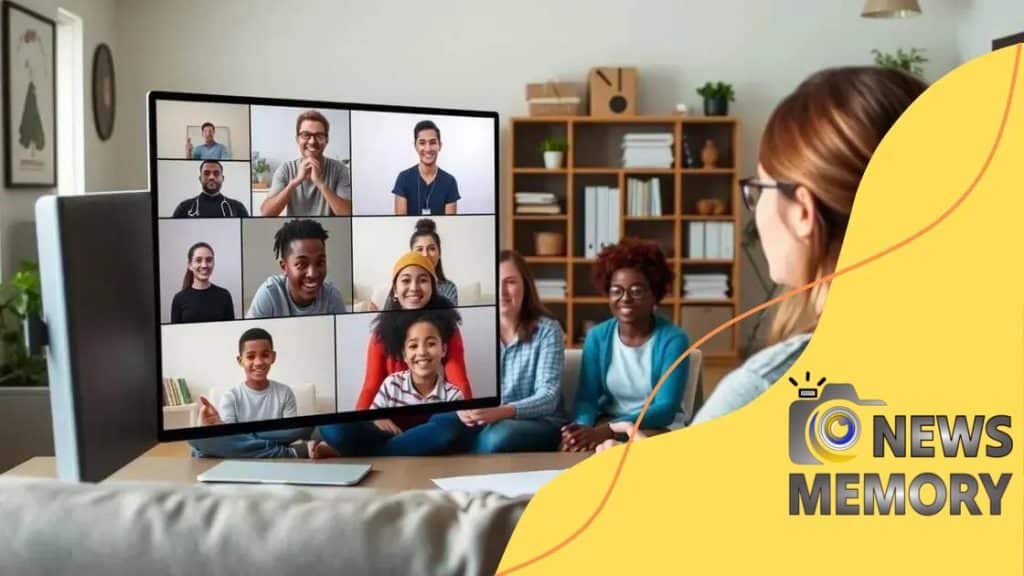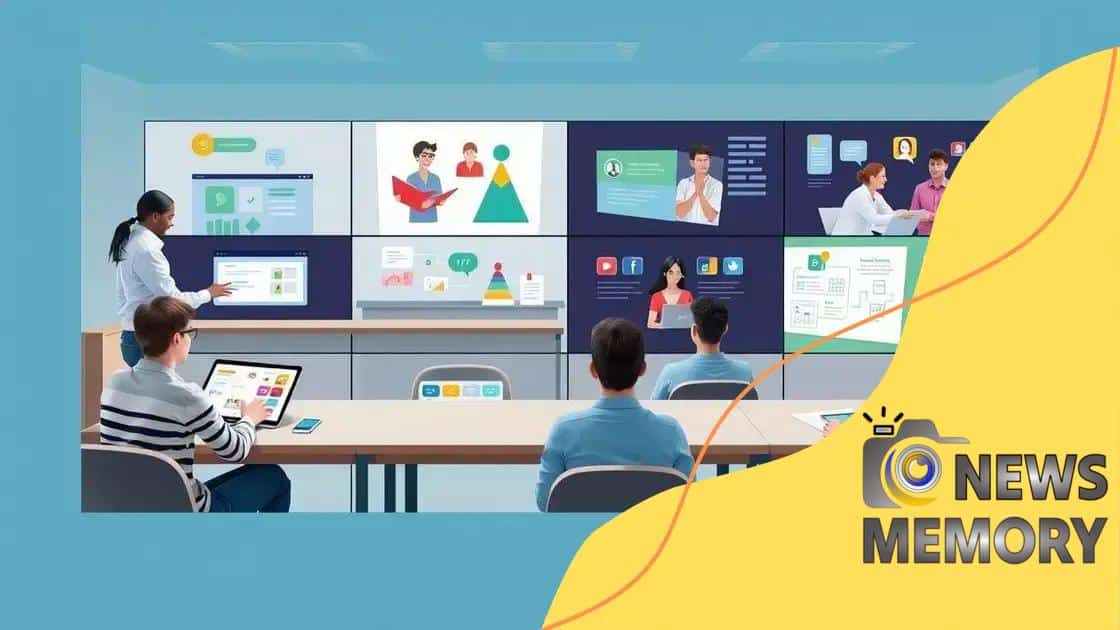Virtual classrooms in developing countries: A key to success

Virtual classrooms in developing countries enhance educational access through technology, but challenges like internet accessibility and digital literacy must be addressed to maximize their effectiveness.
Virtual classrooms in developing countries are changing the landscape of education. But what does this mean for students and teachers? Let’s dive into the opportunities and hurdles they face.
Understanding virtual classrooms
Understanding virtual classrooms is essential for grasping their impact on education in developing countries. These platforms facilitate learning by bridging gaps typically caused by geographical and resource barriers, allowing students to engage with materials and instructors remotely.
What are virtual classrooms?
A virtual classroom is an online space where students and teachers interact in real-time, using technology to access educational resources. This format promotes a flexible learning environment, making education more accessible.
Key features of virtual classrooms
- Live Streaming: Instructors deliver lessons live, fostering interaction.
- Resource Sharing: Students can access various materials like videos and articles.
- Discussion Forums: Interaction is facilitated through chat features.
Furthermore, these classrooms are not just about functionality; they also create opportunities for building a community among learners. Students from different regions can collaborate, share ideas, and support each other, preparing them for a globalized world.
However, it is crucial to recognize the challenges that come with transitioning to this online format. Issues such as internet connectivity and digital literacy can pose barriers to effective learning in many areas. Teachers must be adaptable and use diverse strategies to ensure all students can participate.
Benefits of virtual classrooms
The advantages of virtual classrooms are significant. They enable customized education as students can learn at their own pace. Besides, schools can save on infrastructure costs, allowing funds to be redirected towards better learning materials and technology.
Additionally, parents can be more involved in their child’s education, as they have better access to resources and schedules. As communities embrace technology, optimism grows for a brighter future where education is within the reach of everyone, regardless of their background.
Technology accessibility issues
Technology accessibility issues are critical when discussing virtual classrooms in developing countries. These challenges can hinder students’ ability to learn effectively. Many regions still face limited access to reliable internet and devices, impacting the overall educational experience.
Key challenges in technology accessibility
Despite the potential benefits, several factors contribute to accessibility issues. Often, students do not have the necessary tools to engage with online learning platforms. This lack of resources can create disparities between students in urban versus rural areas.
- Internet Connectivity: Many students struggle to connect to the internet, making it difficult to participate in classes.
- Device Availability: Access to laptops or tablets is often limited, forcing students to rely on inadequate alternatives.
- Digital Literacy: A lack of skills in using technology can prevent students from fully engaging with virtual learning.
In addition to these challenges, many families may not prioritize technology due to other pressing needs. This creates a situation where educational opportunities are missed. The digital divide continues to grow, affecting not only students but also teachers who may lack training in using online platforms effectively.
Furthermore, the socio-economic status of households can significantly impact technology accessibility. In many cases, families cannot afford the costs associated with maintaining internet access or purchasing devices. Solutions must address these disparities to ensure that education remains equitable.
Addressing accessibility challenges
To improve accessibility, many initiatives focus on bridging the digital divide. Governments and organizations are working together to enhance infrastructure in underserved areas, providing better internet access. Additionally, programs that donate devices to students can facilitate their learning experience.
Furthermore, incorporating training programs on digital literacy can empower both students and teachers. This approach not only improves learning outcomes but also helps communities embrace digital technology as a vital part of their educational framework.
Pedagogical approaches in virtual learning

Pedagogical approaches in virtual learning play a vital role in shaping how students engage with educational content. These methods help educators tailor their teaching strategies to meet the diverse needs of students in virtual classrooms.
Effective teaching strategies
Utilizing effective teaching strategies is crucial for success in an online environment. Educators should consider various approaches to maintain student interest and enhance understanding.
- Interactive Learning: Incorporating interactive elements, such as polls and quizzes, keeps students engaged.
- Collaborative Projects: Group work fosters teamwork and helps students learn from each other.
- Multimedia Resources: Using videos and graphics can simplify complex concepts.
These strategies create a more dynamic learning atmosphere. When students actively participate, they are more likely to retain information. Additionally, adapting lessons to include visual and auditory elements caters to different learning styles.
Moreover, the role of feedback cannot be overlooked. Providing timely and constructive feedback helps students identify their strengths and areas for improvement. Teachers can use tools like video comments or written annotations to enhance the feedback process.
Supporting diverse learners
In virtual learning, it’s important to support diverse learners with different needs. This can be achieved through personalized learning paths. For example, offering various assignment options allows students to choose tasks that match their interests and abilities.
Additionally, incorporating assistive technologies can provide benefits to students with disabilities. Tools such as screen readers and speech-to-text software ensure that all students can access and participate in the learning process.
Creating an inclusive environment also means fostering a sense of community among students. Encouraging discussion forums and online meet-ups helps students feel connected to their peers and teachers, which is essential for their motivation and engagement.
Case studies of success
Case studies of success illustrate the positive impact of virtual classrooms in developing countries. These examples provide valuable insights into how technology can transform education and overcome barriers.
Example 1: Rural Education Initiative
In a rural area in India, a project implemented virtual classrooms to connect students with educators in urban centers. By using online platforms, students gained access to high-quality teaching resources. This initiative not only improved knowledge but also motivated students to pursue higher education.
Example 2: Kenya’s E-Learning Program
Kenya’s government launched an e-learning program that provided tablets loaded with educational content to students in remote schools. The program fostered an engaging learning environment and enhanced communication between teachers and students.
- Increased Engagement: Students were more excited about learning with interactive content.
- Flexibility: Learners could access materials anytime, encouraging independent study.
- Support for Teachers: Teachers received training on incorporating technology into their lessons.
This case shows that when resources are allocated correctly, students can thrive in an online setting.
Additionally, projects in countries like Brazil have demonstrated the effectiveness of using social media platforms to create learning communities. Through these platforms, students engage in discussions and collaborative projects, enhancing their educational experience.
Example 3: South Africa’s Virtual Learning Hub
A virtual hub in South Africa connected learners and educators through webinars and online resources, promoting collaboration. This initiative expanded access to quality education for students who may otherwise have limited options.
Through the virtual learning hub, many students reported improved academic performance and greater confidence in their abilities. Success stories like these showcase that with the right support and resources, virtual classrooms can transform education in developing regions.
Future prospects and challenges
Future prospects and challenges in virtual classrooms are important considerations for developing countries. As technology continues to advance, the potential for improved educational access remains high. However, obstacles must be addressed to fully realize these opportunities.
Growing access to technology
One promising prospect is the increasing availability of affordable technology. With the rise of low-cost smartphones and tablets, more students can access educational materials online. This trend opens doors for greater engagement and learning, especially in remote areas.
Innovative pedagogical practices
Emerging teaching methods can enhance the effectiveness of virtual classrooms. For example, blended learning combines online and face-to-face instruction, allowing for a more personalized learning experience. Additionally, gamified learning platforms can motivate students to engage actively and enjoyably.
- Adaptive Learning: This approach tailors lessons to meet individual student needs, ensuring that each learner progresses at their own pace.
- Project-Based Learning: This method encourages collaboration and critical thinking by having students work on real-world projects.
- Social Learning: Facilitating learning through peer interactions fosters community and enhances understanding.
These innovative practices hold great potential for improving educational outcomes. However, it is essential to ensure that educators receive adequate training to implement these approaches successfully.
Challenges to overcome
Despite the positive trends, several challenges threaten progress. Funding for technology and internet infrastructure remains a significant barrier in many regions. Without sufficient investment, advancements may be slow and uneven.
Moreover, digital literacy is a vital skill that must be developed among both students and teachers. Providing training programs on technology usage ensures that all parties can benefit from online learning environments.
Additionally, there is a need for policy support to integrate virtual classrooms into national education systems effectively. Governments must prioritize education and technology initiatives to build a robust foundation for future learning.
FAQ – Common Questions about Virtual Classrooms in Developing Countries
What are the main benefits of virtual classrooms?
Virtual classrooms provide greater access to education, flexibility in learning, and the ability to connect with quality resources and educators.
What challenges do students face in virtual classrooms?
Students often face issues like limited internet access, a lack of devices, and varying levels of digital literacy.
How can teachers engage students in virtual learning?
Teachers can engage students by using interactive tools, incorporating multimedia content, and encouraging group projects to foster collaboration.
What is the role of technology in improving education?
Technology plays a crucial role in enhancing educational access, providing innovative learning methods, and facilitating communication between students and teachers.





